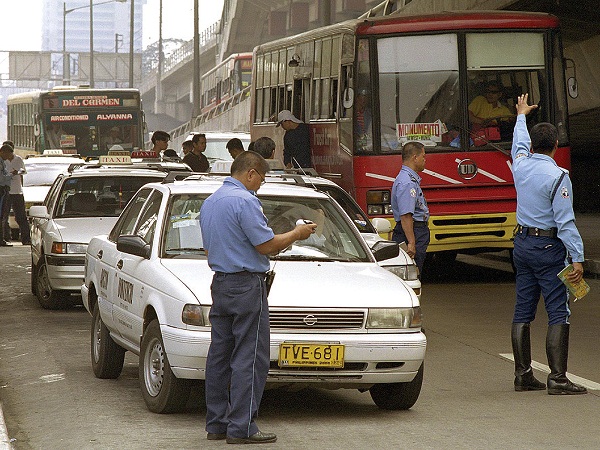MMDA’s ‘bullied’ blue boys: All in a day’s work
He was not the first and surely won’t be the last. Saturnino Fabros shot to YouTube fame last month for standing up to a Volvo-driving bully, but he was only the latest in a long list of traffic aides who had been taunted or assaulted while trying to impose order on the mean streets of Metro Manila.
In February this year, Raul Reoteres was mauled by around 30 men whose drag race he tried to break up on Diosdado Macapagal Boulevard in Pasay City. In 2011, Larry Fiala was shot three times in San Juan while chasing a violator of the number coding scheme.
They’re no saints, no robots, and they have their own share of bad eggs in their ranks. But the “blue boys” (and girls) of the Metropolitan Manila Development Authority (MMDA) perform one of the most hazardous jobs in the government.
They are trained to show proper decorum in apprehending traffic violators, but there are no black-and-white rules to guide them when dealing with bullies and so-called untouchables, according to Danilo Parreño, chief of the MMDA Western Traffic Enforcement Division.
“That’s one of the difficult parts of the job. You don’t really know who you’re facing. You wouldn’t know if (the motorist) has a gun or what,” Parreño said. “If he’s armed, would you still try to book him?”
Article continues after this advertisementHe said trouble usually starts when the motorist snarls back: “Hindi mo ba ’ko kilala? (Don’t you know who you’re dealing with?)”
Article continues after this advertisementThe MMDA does not issue firearms to traffic aides, though Parreño conceded that some officers may be keeping guns in their private capacity. The blue boys used to wield nightsticks and carry tear gas canisters in the mid-’90s, but reports of rampant abuses led to their total disarming.
Before they are deployed, they undergo a series of seminars and tests at the agency’s Traffic Academy in Sta. Mesa, Manila. A high school graduate can take the entry-level position of Traffic Constable 1 by completing a 45-day seminar. Other seminars teach a range of skills that include basic self-defense.
Still, there is no textbook procedure for dealing with awkward or potentially dangerous situations. “Sometimes, the violators are policemen or public officials. How would an enforcer know especially if these officials are not in uniform?”
Traffic Operation Officer 3 Ruby Bron recounted how a motorist she apprehended in 2007 for driving a colorum vehicle brandished a gun to scare her. The motorist turned out to be a policeman in civilian clothes; at the sight of the gun, she was forced to withdraw.
‘Son of politician’
For Oliver Bunuan, road bullies come in many varieties, the most typical being those who claim to be “the son of this or that politician, etc.” He admitted that he usually let these arrogant violators go, thinking they would eventually “meet their match.”
For “evidence,” Bunuan said, he tries to capture such touchy encounters on video with his cell phone camera.
Some motorists, after being forced to surrender their licenses, retaliate by filing counter-complaints.
Cesar Bondoc, who manned the streets for 15 years and is now posted at the MMDA Command Center, said he once flagged down a female driver who feigned ignorance of the number coding scheme.
The woman later questioned the citation and filed a complaint in the MMDA, forcing Bondoc to spend extra for transportation just to attend the hearings beyond his work hours. The complaint did not prosper.
“Some motorists have this mentality: ‘If you wasted my time, then I’ll also waste yours.’ This poses an additional burden to an MMDA enforcer who has worked all day on the street,” Parreño said.
Hence, one could not really blame some traffic enforcers when they show some leniency. “Sometimes they really just let a violator go to avoid going through all that trouble,” he said.
Monthly pay
Rising from the ranks may be hard for traffic aides without additional training or accreditation. Without passing the civil service exams, one could remain a Constable 1 despite long years of service, receiving only about P10,000 a month.
A Constable 2 gets around P12,000; Constable 3, P15,000; Traffic Operations Officer 1, P20,000; and Officer 2, P25,000, according to Parreño.
The MMDA allots a P5,000 clothing allowance per traffic aide. Looking smart and tough is crucial: Road bullies usually get more aggressive when they see that they are dealing with a timid, lousily dressed enforcer.
Bondoc conceded that motorists tend to look down on his line of work. Now in his 40s, he started working at the MMDA at age 25. A mechanical engineering graduate of Manuel L. Quezon University, Bondoc said he took the government job after three years of being a contractual worker in the private sector.
He said he didn’t take much pride in his work at first, but later realized the importance of what he and his peers do in addressing Metro Manila’s perennial traffic jams.
He has practically memorized all the traffic regulations, but knows that such mastery is not enough.
Back when he was still assigned in the field, he said, “I was never afraid to apprehend congressmen or lawyers. I hold on to the principle: No one is above the law. This makes me confident about my job to this day.”
